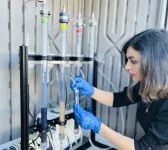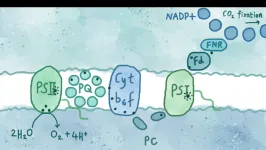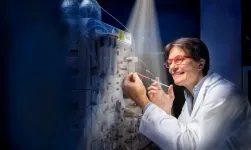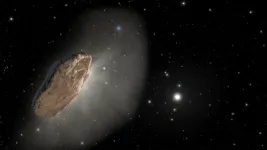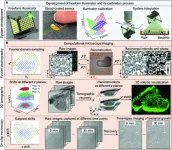(Press-News.org) ITHACA, N.Y. -- A model system created by stacking a pair of monolayer semiconductors is giving physicists a simpler way to study confounding quantum behavior, from heavy fermions to exotic quantum phase transitions.
The group’s paper, “Gate-Tunable Heavy Fermions in a Moiré Kondo Lattice,” published March 15 in Nature. The lead author is postdoctoral fellow Wenjin Zhao in the Kavli Institute at Cornell.
The project was led by Kin Fai Mak, professor of physics in the College of Arts and Sciences, and Jie Shan, professor of applied and engineering physics in Cornell Engineering and in A&S, the paper’s co-senior authors. Both researchers are members of the Kavli Institute; they came to Cornell through the provost’s Nanoscale Science and Microsystems Engineering (NEXT Nano) initiative.
The team set out to address what is known as the Kondo effect, named after Japanese theoretical physicist Jun Kondo. About six decades ago, experimental physicists discovered that by taking a metal and substituting even a small number of atoms with magnetic impurities, they could scatter the material’s conduction electrons and radically alter its resistivity.
That phenomenon puzzled physicists, but Kondo explained it with a model that showed how conduction electrons can “screen” the magnetic impurities, such that the electron spin pairs with the spin of a magnetic impurity in opposite directions, forming a singlet.
While the Kondo impurity problem is now well understood, the Kondo lattice problem – one with a regular lattice of magnetic moments instead of random magnetic impurities – is much more complicated and continues to stump physicists. Experimental studies of the Kondo lattice problem usually involve intermetallic compounds of rare earth elements, but these materials have their own limitations.
“When you move all the way down to the bottom of the Periodic Table, you end up with something like 70 electrons in an atom,” Mak said. “The electronic structure of the material becomes so complicated. It is very difficult to describe what’s going on even without Kondo interactions.”
The researchers simulated the Kondo lattice by stacking ultrathin monolayers of two semiconductors: molybdenum ditelluride, tuned to a Mott insulating state, and tungsten diselenide, which was doped with itinerant conduction electrons. These materials are much simpler than bulky intermetallic compounds, and they are stacked with a clever twist. By rotating the layers at a 180-degree angle, their overlap results in a moiré lattice pattern that traps individual electrons in tiny slots, similar to eggs in an egg carton.
This configuration avoids the complication of dozens of electrons jumbling together in the rare earth elements. And instead of requiring chemistry to prepare the regular array of magnetic moments in the intermetallic compounds, the simplified Kondo lattice only needs a battery. When a voltage is applied just right, the material is ordered into forming a lattice of spins, and when one dials to a different voltage, the spins are quenched, producing a continuously tunable system.
“Everything becomes much simpler and much more controllable,” Mak said.
The researchers were able to continuously tune the electron mass and density of the spins, which cannot be done in a conventional material, and in the process they observed that the electrons dressed with the spin lattice can become 10 to 20 times heavier than the “bare” electrons, depending on the voltage applied.
The tunability can also induce quantum phase transitions whereby heavy electrons turn into light electrons with, in between, the possible emergence of a “strange” metal phase, in which electrical resistance increases linearly with temperature. The realization of this type of transition could be particularly useful for understanding the high-temperature superconducting phenomenology in copper oxides.
“Our results could provide a laboratory benchmark for theorists,” Mak said. “In condensed matter physics, theorists are trying to deal with the complicated problem of a trillion interacting electrons. It would be great if they don’t have to worry about other complications, such as chemistry and material science, in real materials. So they often study these materials with a ‘spherical cow’ Kondo lattice model. In the real world you cannot create a spherical cow, but in our material now we’ve created one for the Kondo lattice.”
Co-authors include doctoral students Bowen Shen and Zui Tao; postdoctoral researchers Kaifei Kang and Zhongdong Han; and researchers from the National Institute for Materials Science in Tsukuba, Japan.
The research was primarily supported by the Air Force Office of Scientific Research, the National Science Foundation, the U.S. Department of Energy and the Gordon and Betty Moore Foundation.
-30-
END
Semiconductor lattice marries electrons and magnetic moments
2023-03-22
ELSE PRESS RELEASES FROM THIS DATE:
Nominations sought for 2024 Watanabe Prize in Translational Research
2023-03-22
Indiana University School of Medicine is accepting nominations until May 1 for the 2024 August M. Watanabe Prize in Translational Research.
The Watanabe Prize is one of the nation’s largest and most prestigious research awards recognizing senior investigators focused on shepherding scientific discoveries into new therapies for patients. Nominees should be members of the scientific or medical communities who have demonstrated outstanding accomplishments in translational research.
The winner will receive $100,000 and will spend Sept. 18-20, 2024, in Indianapolis as a vising dignitary, sharing insights and knowledge with audiences at IU School of Medicine and its partner institutions. ...
Dr. Ekta Khurana receives grant to study prostate cancer evolution
2023-03-22
Dr. Ekta Khurana, an associate professor of physiology and biophysics at Weill Cornell Medicine, has received a 3-year, $1.2 million grant from the United States Department of Defense to investigate how prostate cancer cells evolve to become resistant to hormone-blocking therapy. This work will contribute to further understanding prostate cancer and the development of effective targeted therapies for the disease.
Prostate cancer growth is dependent on androgens – male hormones such as testosterone – binding ...
New UBC water treatment zaps ‘forever chemicals’ for good
2023-03-22
Engineers at the University of British Columbia have developed a new water treatment that removes “forever chemicals” from drinking water safely, efficiently – and for good.
“Think Brita filter, but a thousand times better,” says UBC chemical and biological engineering professor Dr. Madjid Mohseni, who developed the technology.
Forever chemicals, formally known as PFAS (per-and polyfluoroalkyl substances) are a large group of substances that make certain products non-stick or stain-resistant. There are more than ...
Photosynthesis ‘hack’ could lead to new ways of generating renewable energy
2023-03-22
Researchers have ‘hacked’ the earliest stages of photosynthesis, the natural machine that powers the vast majority of life on Earth, and discovered new ways to extract energy from the process, a finding that could lead to new ways of generating clean fuel and renewable energy.
An international team of physicists, chemists and biologists, led by the University of Cambridge, was able to study photosynthesis – the process by which plants, algae and some bacteria convert sunlight into energy – ...
Simulated terrible drivers cut the time and cost of AV testing by a factor of one thousand
2023-03-22
Photos // Video
The push toward truly autonomous vehicles has been hindered by the cost and time associated with safety testing, but a new system developed at the University of Michigan shows that artificial intelligence can reduce the testing miles required by 99.99%.
It could kick off a paradigm shift that enables manufacturers to more quickly verify whether their autonomous vehicle technology can save lives and reduce crashes. In a simulated environment, vehicles trained by artificial intelligence perform perilous maneuvers, forcing the AV to make decisions that confront drivers only rarely on ...
Multiple substance use disorders may share inherited genetic signature
2023-03-22
A new study suggests that a common genetic signature may increase a person’s risk of developing substance use disorders, regardless of whether the addiction is to alcohol, tobacco, cannabis or opioids. The research, led by Washington University School of Medicine in St. Louis, eventually could lead to universal therapies to treat multiple substance use disorders and potentially help people diagnosed with more than one.
Published March 22 in the journal Nature Mental Health, the study’s findings are drawn from an analysis of genomic data from more than 1.1 million people of mostly European ancestry and a smaller ...
How vision begins
2023-03-22
Researchers at the Paul Scherrer Institute PSI have deciphered the molecular processes that first occur in the eye when light hits the retina. The processes – which take only a fraction of a trillionth of a second – are essential for human sight. The study has now been published in the scientific journal Nature.
It only involves a microscopic change of a protein in our retina, and this change occurs within an incredibly small time frame: it is the very first step in our light perception and ability to see. It is also the ...
New NIH study reveals shared genetic markers underlying substance use disorders
2023-03-22
By combing through genomic data of over 1 million people, scientists have identified genes commonly inherited across addiction disorders, regardless of the substance being used. This dataset – one of the largest of its kind – may help reveal new treatment targets across multiple substance use disorders, including for people diagnosed with more than one. The findings also reinforce the role of the dopamine system in addiction, by showing that the combination of genes underlying addiction disorders was also associated with regulation of dopamine signaling.
Published ...
Surprisingly simple explanation for the alien comet 'Oumuamua's weird orbit
2023-03-22
In 2017, a mysterious comet dubbed 'Oumuamua fired the imaginations of scientists and the public alike. It was the first known visitor from outside our solar system, it had no bright coma or dust tail, like most comets, and a peculiar shape — something between a cigar and a pancake — and its small size more befitted an asteroid than a comet.
But the fact that it was accelerating away from the sun in a way that astronomers could not explain perplexed scientists, leading some to suggest that it was an alien spaceship.
Now, a University of California, Berkeley, astrochemist ...
Smaller, denser, better illuminators for computational microscopy
2023-03-22
Seeking to expand the possibilities offered by programmable illumination, a group of researchers at the University of Connecticut developed a strategy for constructing and calibrating freeform illuminators offering greater flexibility for computational microscopy. Their calibration method uses a blood-coated sensor for reconstruction of light source positions. They demonstrated the use of calibrated freeform illuminators for Fourier ptychographic microscopy, 3D tomographic imaging and on-chip microscopy and used a calibrated freeform illuminator in an experiment to track bacterial growth.
The group’s research was published Feb. 20 in Intelligent Computing, a Science ...

